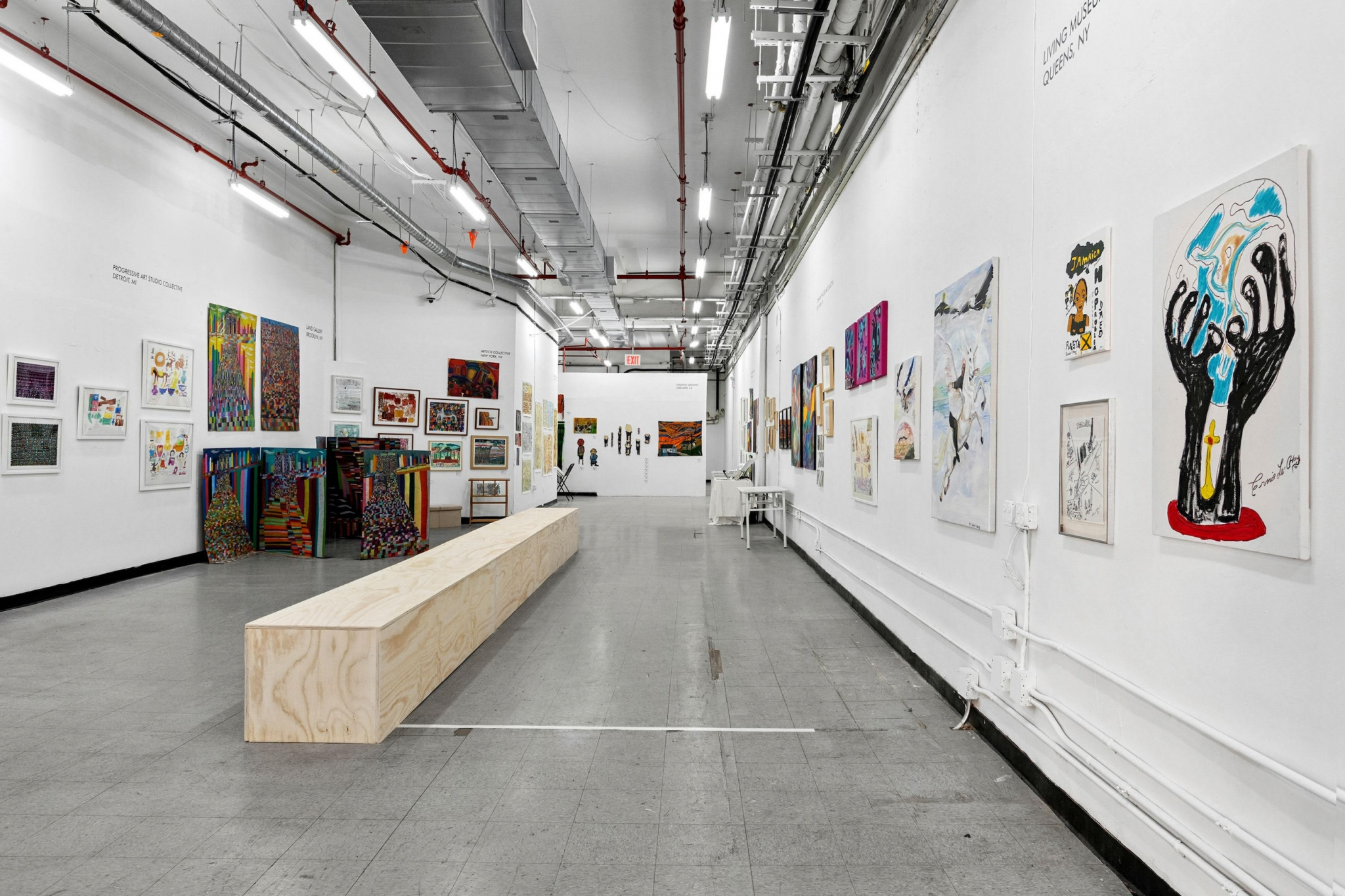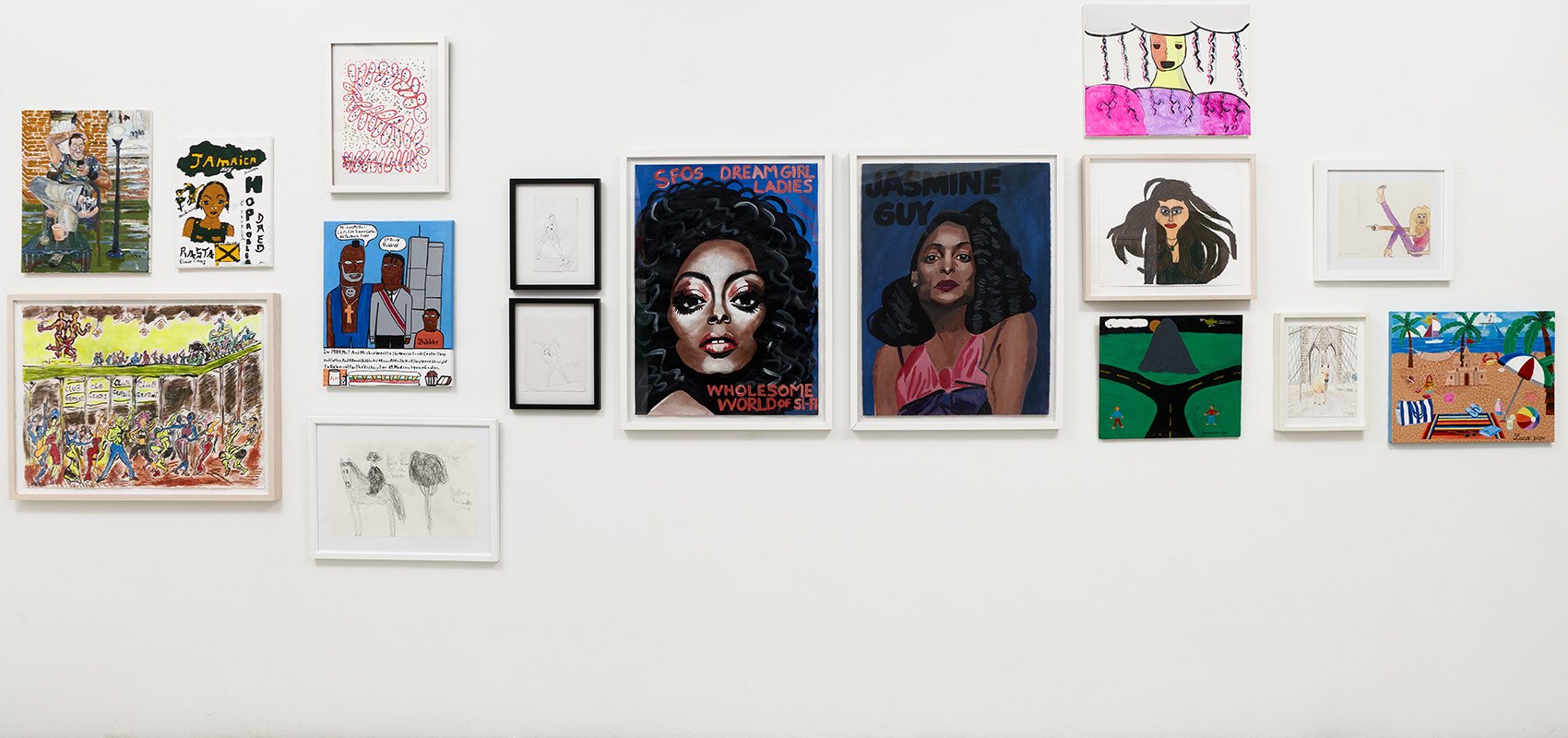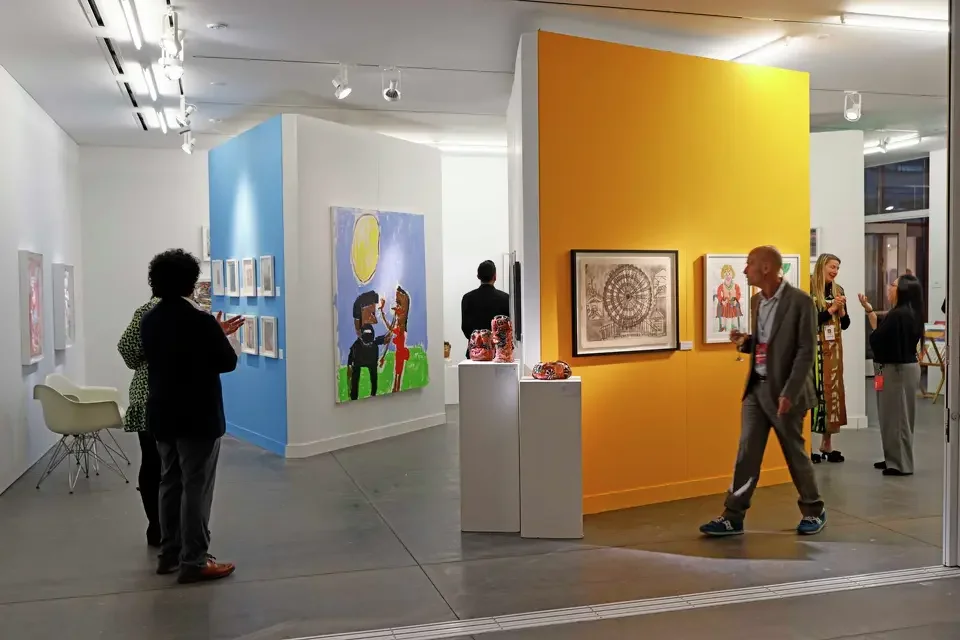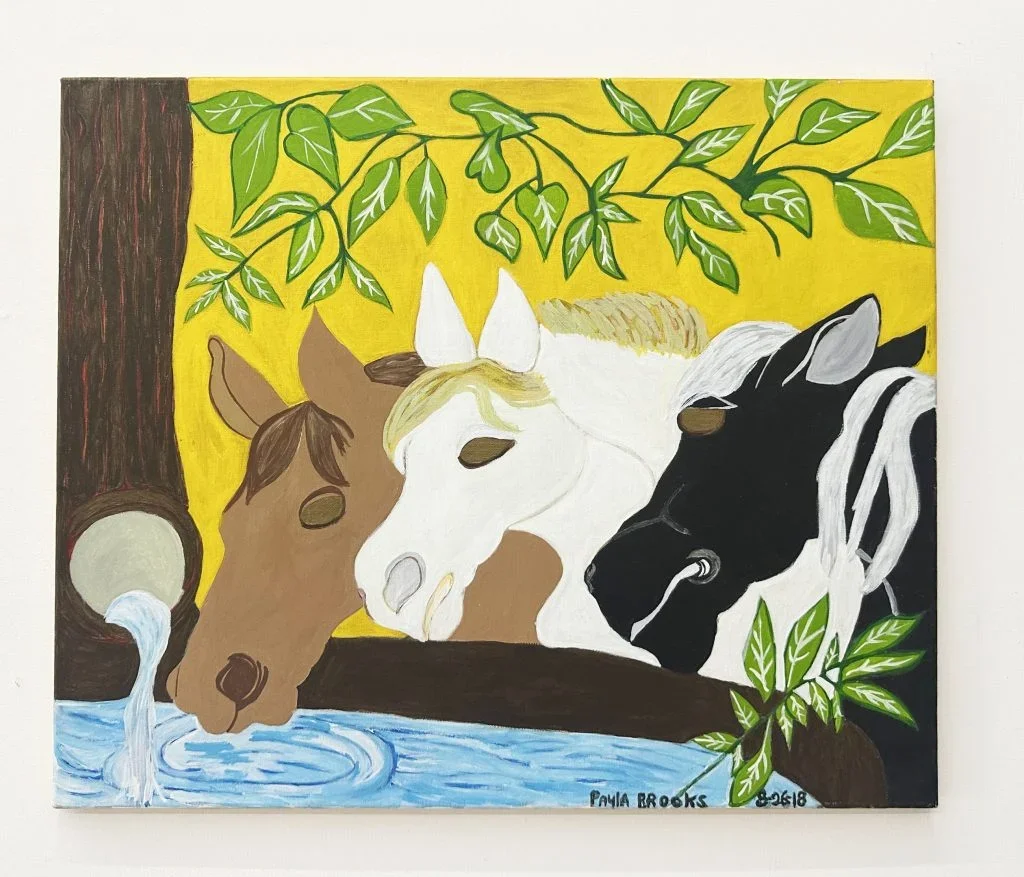At the Open Invitational Micro-Fair, Prices Are Low and Spirits Are High
by Brian Boucher September 5, 2025, artnet
Focusing on artists with disabilities, the fair drew major VIPs in its opening hours.
On Thursday afternoon, as much of the New York art world streamed toward the Javits Center for the Armory Show, which has over 230 exhibitors, I headed downtown to Open Invitational, a micro-fair hosting nine studios that support artists with disabilities. It’s taking place through Sunday afternoon at 356 Broadway, in the gallery-rich Tribeca neighborhood.
Open Invitational 2025 in New York. Photo: Nikola Strbac.
The granddaddy of these progressive art studios (also sometimes called supportive art studios or disability art studios), founded in 1974, is the San Francisco Bay Area’s Creative Growth, which is on the roster here, along with New York’s Artech Collective; Philadelphia’s Center for Creative Works; Community Access Art Collective, New York; Creativity Explored, of San Francisco; LAND Studio and Gallery, Brooklyn; the Living Museum, from Queens; Progressive Art Studio Collective, Detroit; and Studio Route 29, of Frenchtown, New Jersey. All have worthy offerings, and prices start as low as a hundred bucks (I bought a Paulino Martin work at that price from Creative Growth; you’ll find your own bargains).
At midday Thursday, the vibe was strong; portable speakers played an invigorating playlist as New York VIPs came through, including musician David Byrne; curator Gary Carrion-Murayari from the New Museum; Matthew Higgs, director of White Columns; critic Bob Nickas; and curator Valérie Rousseau of the American Folk Art Museum.
The fair is the brainchild of New York dealer David Fierman and Miami-based arts patron Ross McCalla, who were both beaming. It launched in Miami’s Design District in December 2024; Artnet’s Andrew Russeth proclaimed it “a stunner, the quiet hit of the week.” (With Land Gallery’s Rachel Carle Cohen, Fierman also recently opened a New York gallerydevoted to artists with disabilities.)
“The exhibitors gave me $500, and I put on this fair for half what I would pay for an ‘Armory Presents’ booth,” Fierman told me, seated on a bench in the middle of the room. (According to recent Artnet reportingby Annie Armstrong, those go for between $13,000 and $21,000.) “Our friend Efraín López has a gallery in the building, and he let us know the space was available,” Fierman added. Dealers are all showing in one long room, with no dividing walls, promoting a sense of togetherness.
“The market is down,” Fierman added, “so it’s a time for ingenuity, good energy, building community, and lifting all boats together.” This particular boat really does seem to be rising; Fierman told me that they’ll be back in Miami in December in a bigger space, and that they’ll also soon do a fair with Creativity Explored in San Francisco. Though other galleries and fairs are closing left and right, spirits are high at 356 Broadway.
At the Living Museum, I loved paintings by Nyla Isaac, in which she depicts herself on the back of a winged horse soaring through the air, accompanied by eagles. You can practically feel the brisk air at her altitude. For Fierman, the scene recalls the Rococo stylings of François Boucher; for me, seeing a Black woman painted in the style of an Old Master recalled Kehinde Wiley. The Trinidadian-American artist studied art and fashion illustration at New York’s Fashion Institute of Technology, but schizophrenia knocked her off the professional track in her 20s. The larger painting is tagged at $5,000.
I’m trying to figure out how I could possibly install Robert Latchman’s charming large paintings on cardboard depicting the Brooklyn Bridge, on view courtesy of Brooklyn’s Land Gallery, in my small apartment. Some hang on the wall, but the ones I have my eye on are done on sheets of cardboard several feet wide that are folded and propped on the floor, recalling Japanese screens. Rachel Carle Cohen of Land, tears in her eyes, told me that the artist has steel bars in his legs after a devastating 2010 car accident; the bridge similarly has steel bars in its columns, so the artist feels he can relate to the iconic structure. Wall-hung paintings go for $2,500, the floor-standing pieces for $5,000.
Studio Route 29 is offering painted-over found photographs by Katie House, who works in many mediums and was the first artist to begin working at the studio. There’s a very nice sense of mystery to the unknown backstories of the photographs, some of which show people formally sitting for portraits, some of which are candid shots; in just about all cases, eyes are painted over, lending a sometimes eerie, sometimes funny effect. “I just want to know who these people are, you know what I mean?” says the artist in a statement, also saying, “I want there to be a before and after to the photographs.” Prices are in the range of a few hundred dollars.
Andrew Li’s ink and watercolor works, at Creativity Explored, are ambitious in scale and rich in detail, teeming with animal and human figures, sometimes painstakingly labeled, and, since the artist loves public transportation, planes, trains, and automobiles. In Untitled (Dog Rescue), from 2019, dogs are lovingly inscribed with names: Wendy, Ann, Kim, and Barbara are all in attendance. Even large sheets, ranging more than four feet wide, are priced between just $1,000 and $2,000.
At a fair for outsider artists, there’s a fundamentally different vibe from events where the artists are generally more professionalized. The dealers take evident joy in promoting the artists, helping people support themselves when the odds are stacked against them. And buying similarly brings an invigorating feeling of rooting for the underdog.
Harriet Salmon, staffing the fair for Creativity Explored, told me that some contemporary artists’ goals—a show at the Whitney Museum, say—can be a stretch. The artists showing at fairs like this are different. “They say, ‘I want people to see my work,’ or ‘I want to have a show my family can come see,’ or ‘I want people to know how I see the world,’” she told me. “Those are very achievable goals. And I can do it. And it feels really good.”
New York City’s Open Studio Takes Elitism out of Art
By Ally Reavis, Mission Magazine
Open Studio invites viewers into an inclusive, caring art world. The space opened in July, with Open Studio, and a group exhibition at the nearby FIERMAN.
On a quiet corner in New York City’s Chinatown, a new gallery is helping flip the script on the art world. Co-founded by Rachel Carle Cohen and David Fierman, Open Studio is the first gallery in the city dedicated exclusively to artists with disabilities, most of them affiliated with progressive art studios across the country.
Progressive art studios “serve as community centers and third spaces for people who are often isolated,” said Fierman. They supply materials and provide mentorship, stability, therapy, and professionalization for artists with intellectual, developmental, or mental health disabilities.
Fierman and Cohen dreamed up the gallery during last year’s Open Invitational, a Miami art fair Fierman founded to spotlight artists from these studios.
“The energy of the fair, both from the public and the fun we were having on the inside, made it a no-brainer to turn it into a gallery,” said Fierman. “The art world is on a constant hunt for authenticity and the thrill of discovering overlooked artists, and it seems our artists are next on the radar.”
Fierman has spent two decades navigating different corners of the art world, first assisting at elite galleries like Salon 94, and eventually opening his own gallery, FIERMAN, in 2016. Open Studio marks a personal shift.
The new gallery opened in July with a dual debut: a solo show of Queens-based artist John Tursi at Open Studio, and a group exhibition celebrating the launch at the nearby FIERMAN. Both exhibits are on until August 15th.
Fierman’s work with The Living Museum at Creedmoor Psychiatric Center in Queens, the progressive studio program where Tursi has worked since the 1990s, made the gallery’s first solo show feel inevitable. “To me, there is no stronger artist than Tursi to push forth,” said Fierman. “He should be looked at in the context of other artists of his generation– Carroll Dunham, Jeff Koons, Mike Kelley.”
“These artists want to participate in the market and the conversation, so we just need to look and listen.”
David Fierman
Tursi’s work embodies the raw honesty, inventiveness, and lack of posturing that make the work coming from progressive art studios so captivating. His exhibition, Lozenges, is a burst of colorful, layered recurring symbols held together by an intuitive internal rhythm.
“The public assumes our artists have a greater naivete about them than they do,” said Fierman. “These artists want to participate in the market and the conversation, so we just need to look and listen.”
Photos by Chris Herity. Images courtesy of Open Studio.
The Creativity Explored, NIAD, Creative Growth booth at the Fog Design + Art fair at Fort Mason.
Santiago Mejia/S.F. Chronicle
Exclusive:
New fair for artists with
developmental disabilities
to launch in S.F.
San Francisco is getting another art fair, this one aimed at creating a more inclusive art world.
The leading grant from the second round of Svane Family Foundation’s Culture Forward Grants was awarded to Creativity Explored, the 42-year-old center for artists with developmental disabilities in the Mission District, the foundation announced Thursday, July 31.
The $100,000 grant will allow the organization to host the first Creativity Explored x Open Invitational, which will feature neurodiverse artists from studios across the country. The partnering presenter, the Open Invitational art fair, was founded in Miami in 2024 by gallerist David Fierman and arts patron Ross McCalla, also to show the work of artists with disabilities.
The event will debut during the 2026 edition of San Francisco Art Week, scheduled for Jan. 17-25. The Creativity Explored x Open Invitational is slated to run Jan. 22-25, 2026, and will be hosted in a former South of Market Area office building. (The exact location will be announced later.) Booth fees and commissions for participating art centers will be waived, and admission will be free.
Harriet Salmon, the director of art partnerships at Creativity Explored, said that the organization was thrilled to bring an art fair championing artists with disabilities to downtown San Francisco. She noted that the fair “will expand SF Art Week’s offerings to encompass these important artworks, artists and studios; catalyzing the long-overdue cultural dialogue of who is exhibited, who is collected, and who is discussed.”
Creativity Explored is one of three Bay Area art centers founded by Elias Katz and Florence Ludins-Katz. The San Francisco space is a beloved arts destination where artists both work in studio and present in the front gallery.
Along with sister organizations Creative Growth of Oakland and NIAD Art Center of Richmond, Creativity Explored artists were part of a major acquisition by the San Francisco Museum of Modern Art in 2023 that vastly increased the museum’s holdings by artists with developmental disabilities. That same year, the studios were celebrated in the exhibition “Into the Brightness: Artists From Creativity Explored, Creative Growth & NIAD” at the Oakland Museum of California. The organization is also no stranger to art fairs: In 2024, Creativity Explored as well as NIAD and Creative Growth presented at the inaugural Fog Focus fair extension at Fort Mason. Creativity Explored artists have also collaborated with major brands including home-ware companies Pottery Battern, Crate & Barrel and CB2, as well as Japanese fashion house Comme des Garcons.
San Francisco Art Week has become a significant part of the city’s cultural calendar. Since the founding of the Fog Design + Art fair in 2014, local galleries and arts organizations have taken advantage of the influx of art world visitors by opening their spaces and hosting coinciding special events. In 2024, the week became more centralized when art adviser Emily Counihan developed an organizing calendar and a website for happenings.
While much of the Art Week programming will center on the Fog fair at Fort Mason, the Creativity Explored x Open Invitational will be a significant anchor downtown. The Culture Forward grants were created to support arts and cultural initiatives that sought to bring people to the city core.
In addition to Creativity Explored, 11 organizations including Cultura y Arte Nativa de las Americas, Drag Story Hour, the Museum of the African Diaspora and KALW Public Media were given grants for public programming in the downtown area. Los Angeles artist Lily Kwong was also awarded $25,000 for the project “Art at a Time Like This | Bloom Route,” where she will create a sculptural native garden and community space in an unused plot of city land.
“This round of grantees reflects both enduring cultural practices and the kind of bold experimentation that has long defined Bay Area creativity,” said Kelsey Issel, the Culture Forward director at the Svane Family Foundation. “Culture Forward is investing in culture makers who are testing what’s possible for downtown San Francisco’s creative future.”
Two New York Dealers
Launch a Gallery
for Artists With Disabilities
Rachel Carle Cohen and David Fierman aim to build on the success of the Open Invitational art fair in Miami last December.
by Brian Boucher July 8, 2025
As the art world continues to work to resolve longstanding issues around accessibility, a pair of New York dealers is launching Open Studio, a downtown gallery that will be fully devoted to work by artists with disabilities. Founded by Rachel Carle Cohen, of Shelter Gallery, and Fierman’s David Fierman, it will focus on those who make their work at progressive art studios (also sometimes called supportive art studios or disability art studios), which began in 1974 with the Bay Area’s Creative Growth. At these facilities, artists with various disabilities are supported in living as artists and also get support in their day-to-day lives.
Paula Brooks, Horses Drinking Water (2018). Courtesy of the artist and the Living Museum.
The distinction between art by untrained artists and the more professionalized art world is increasingly porous, as the Outsider Art Fair draws heavyweight visitors year after year and self-taught artists gain greater institutional acceptance. (See, for one shining example, artist Marlon Mullen’s recent solo show at the temple of Modernism, New York’s Museum of Modern Art.)
Fierman opened his namesake Lower East Side contemporary art gallery in 2016 and has to some degree focused on overlooked, queer, older, and indigenous artists; lately, Fierman has increasingly shown artists with no formal training. Chelsea’s Shelter, since its first exhibition in 2019, has shown emerging artists, with a focus on those left out of the mainstream. Both galleries have participated in prestigious art fairs like NADA and the Outsider Art Fair, and they and their artists have earned notice in publications like the New Yorker, the New York Times, and Artforum.
The new gallery’s name Open Studio was chosen in keeping with a spirit of leveling of boundaries. “We would like to be in a world where you wouldn’t know if an artist had a disability—and it wouldn’t matter,” said Fierman in a conference call with Cohen.
Open Studio throws open its doors July 10, on the hip gallery stretch of Henry Street in the Lower East Side, with a solo show of John Tursi. New York Times critic Roberta Smith once wrote that he came close to “genius status,” saying that his works “dazzle.” The artist works at the Living Museum at Creedmoor Psychiatric Center in Queens, whose director has described him as having a learning disability and “symptoms from various psychiatric afflictions.” Complementing the new gallery is the show “Introducing Open Studio: New Art by Artists with Disabilities” a one-minute walk around the corner at Fierman, including artists such as Montrel Beverly (whose work impressed me at the latest edition of the Outsider Art Fair in New York), Chantel Donwell, Taneya Lovelace, and William Scott.
The gallery’s opening comes at a particularly precarious moment for these art studios, the dealers pointed out, since many of them are funded by Medicaid, which is undergoing harsh cuts as part of the “Big Beautiful Bill” which was signed into law on the Fourth of July. Especially in this moment, said Fierman, they want to train a spotlight on this special kind of “socially integrated art-making.”
In this corner of the art world, said Fierman, “There’s an urgency that’s maybe not felt in other areas of the contemporary art world. There’s an exuberance, a freedom of expression, and there’s something appealing about work that is not made self-consciously for the market, but maybe for other reasons.”
Collectors also feel good, said Cohen, about the fact that their dollars will go “to support people who might be in a rough place.” With artists who work in disability studios, a compelling story often comes together with an accessible price point, she noted.
They’ve already road-tested the idea with a booth for Open Studio at the 2025 NADA New York fair. Cohen said that even people who came into the booth saying they weren’t buying sometimes left having made a purchase.
What’s more, the gallery builds on the success of the Open Invitational, a fair Fierman inaugurated in Miami in December 2024 along with Sunshine State art patron Ross McCalla; at the Invitational, the exhibitors were all progressive art studios. (This specialty distinguishes it from the Outsider Art Fair, where studios exhibit alongside art dealers.) Artnet’s Andrew Russeth dubbed it “a stunner, the quiet hit of the week.” It featured just 11 exhibitors, including the Center for Creative Works in Philadelphia, Creative Growth in Oakland, California, and Vinfen’s Gateway Arts in Boston.
The Miami Design District offered a venue at no charge, and the exhibitors paid nothing for the booths. “We had a beautiful space, and a lot of people came and saw it, the exhibitors had a real boost in visibility from it, and a lot of people sold a lot of work,” said Fierman. He’s cooking up a return edition of the fair for the next Miami art week as well as possible additional Open Invitationals in other cities.
Open Studios joins other New York galleries specializing in this material, from longstanding dealers like Ricco/Maresca and Van Der Plas to newer ones like Shrine, which shows contemporary artists both trained and not. Cohen and Fierman are committed to the field; he is a supporter of the Living Museum at Creedmoor and hosted a show of its artists this past winter, and she penned the 2017 book Outsider Art and Art Therapy: Shared Histories, Current Issues and Future Identities.Cohen previously worked with Brooklyn’s LAND (League Artist Natural Design), which provides studio space and a gallery for artists with disabilities; she describes its work as “teaching life skills through the modality of art.”
They acknowledge that they’re bringing a new gallery into the world at a moment of a weakening art market, but, says Cohen, “It’s a mode of art-making that is a little more recession-proof than the wider contemporary art field.”
“John Tursi: Lozenges” will be at Open Studio, 127 Henry Street, and “Introducing Open Studio: New Art by Artists with Disabilities” will be at Fierman, 19 Pike Street, New York, July 10–August 9, 2025.




